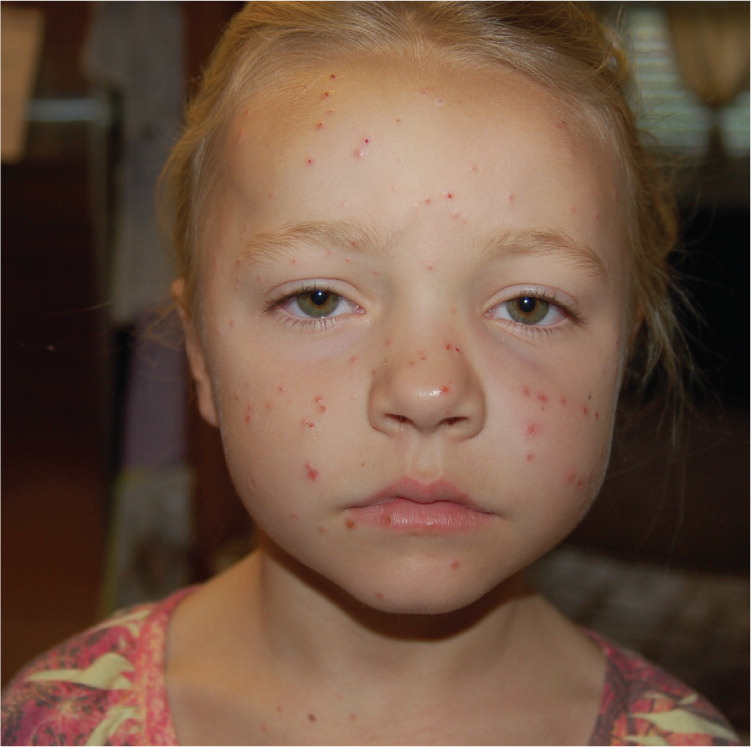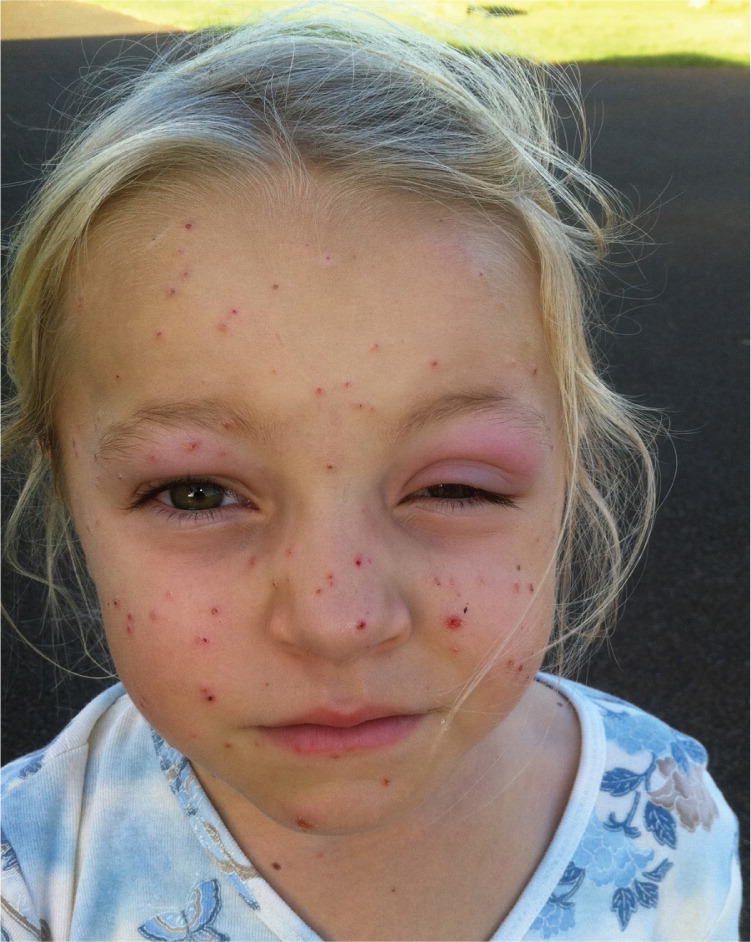
Am Fam Physician. 2013;87(1):59-60
Author disclosure: No relevant financial affiliations to disclose.
A six-year-old girl presented with a papular rash that appeared after a two-day, acute, viral-type illness that included a low-grade fever. The rash first appeared on her face, then spread to her arms, hands, and feet. There were few lesions on her trunk and legs.


Question
Discussion
The answer is B: Gianotti-Crosti syndrome. Gianotti-Crosti syndrome, also known as papular acrodermatitis of childhood, is a self-limited childhood exanthem. With the exception of the pruritic rash, patients are typically asymptomatic and healthy. The benign nature of the condition is the key to the diagnosis.
Although the condition is self-limited, new lesions continue to appear for eight to 11 weeks. Lesions are typically monomorphous, erythematous, and pale pink or flesh colored. The 1- to 10-mm papules or papulovesicles are localized to the extremities and face, and are less common on the buttocks and trunk. The soles and palms may be affected. The arms are more often affected than the legs.
Gianotti-Crosti syndrome was originally thought to be linked to acute hepatitis B virus infection. However, other viral and bacterial infections have been associated with the condition—Epstein-Barr virus infection is the most common in the United States. The underlying pathophysiology is not well understood; however, it is postulated that the condition is a cutaneous immunologic response to transient viremia or bacteremia.
Gianotti-Crosti syndrome occurs sporadically with no apparent genetic or familial predisposition. It may be underdiagnosed because of its benign and self-limited course. It is most common in the spring and early summer, possibly as a result of increased incidence of inciting viral illness during this period. No testing is indicated to confirm the diagnosis.1,2
Erythema multiforme is typically an allergic reaction to medication, infection, or illness. Typical symptoms are fever, general malaise, and arthralgias. The rash often starts with the characteristic target lesion.3
Henoch-Schönlein purpura is characterized by palpable purpura, arthralgias, glomerulonephritis, and abdominal pain. It also typically has an upper respiratory tract infection prodrome. Lesions typically occur in dependent areas, such as the legs and buttocks.4
Papular urticaria is a chronic hypersensitivity reaction attributed to insect bites, although the specific insect is often unknown. Lesions are symmetrically distributed, pruritic papules that are localized to the site of the initial bite, usually on exposed skin.1
The rash of varicella-zoster virus infection typically is preceded by a mild prodrome of fever and malaise. The rash progresses rapidly from vesicular lesions on a red base (dewdrop on a rose petal) to more generalized pruritic pustules and then to crusting papules. They typically occur in successive crops over three or four days, with the highest concentration of lesions on the trunk.5

| Condition | Characteristics |
|---|---|
| Erythema multiforme | Characteristic target lesion; fever, general malaise, arthralgias |
| Gianotti-Crosti syndrome | Self-limited, benign exanthem of childhood; 1- to 10-mm, pruritic papules or papulovesicles, commonly limited to the extremities and face; otherwise asymptomatic; new lesions appear for eight to 11 weeks |
| Henoch-Schönlein purpura | Palpable purpura, arthralgias, glomerulonephritis, abdominal pain; upper respiratory tract infection prodrome |
| Papular urticaria | Chronic hypersensitivity reaction to insect bites; symmetrically distributed, localized, pruritic papules; predominant on exposed skin |
| Varicella-zoster virus infection | Pruritic vesicular lesions on a red base progress rapidly to more generalized pustules, then to crusting papules; lesions appear in successive crops over three or four days, mainly on the trunk |

